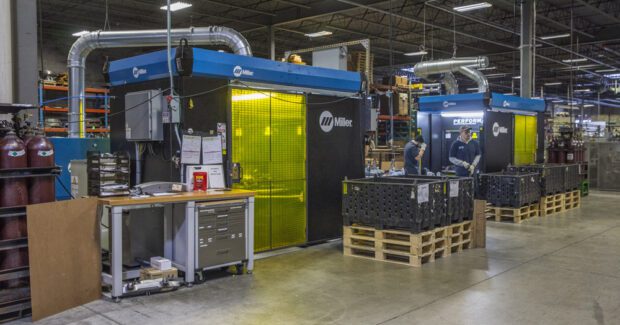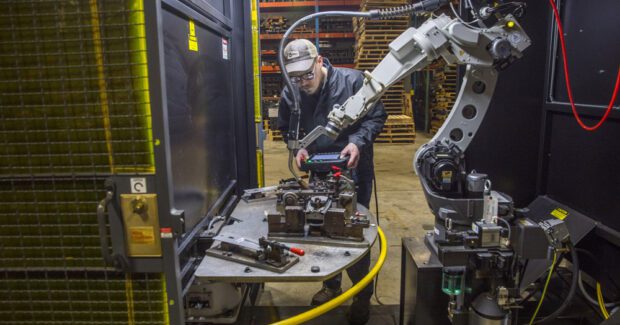Adding Business with Pre-Engineered Robotic Welding Cells
Kenosha Metal Products was new to welding automation, but their PerformArc pre-engineered robotic welding cells from Miller were so successful that they took on enough new business to add three additional workers.
Posted: November 29, 2019
Kenosha Metal Products, Inc. (Pleasant Prairie, WI) is a metal stamping shop with 35 employees and a 71,000 sq ft facility that provides powertrain components, heat transfer systems, brake components, steering column stampings and assemblies to major OEM and Tier suppliers for American, Japanese and European automakers. “Welding is a natural extension of stamping metal fabricated parts,” said Jim MacCracken, the president of the company, which installed a PerformArc™ 350S pre-engineered automated welding cell from Miller Electric (Appleton, WI) that improved their productivity and met quality demands. The shop weighed several factors in making their decision to invest in automated welding. They typically work with small to medium-size stampings and assemblies ranging from simple to more difficult configurations, and producing parts with zero defects and 100 percent on-time delivery are important goals.
Using offline DeskTop Programming and Simulation Software (DTPS), Miller worked with local tooling vendor Sorenson Industrial Systems (Waukesha, WI) to conduct part simulations and cycle time analysis with the PerformArc system. By estimating the weld time and speed, it was also possible to separately estimate consumables costs for the system. “Providing us with estimates and cost structures allowed us to quote jobs, and we were awarded business before we ever bought our first welding system,” explained MacCracken. “If you look at the value-added cost we were awarded by purchasing our first robotic weld cell, it was pretty obvious. We actually had cost returns of less than a year. This was instrumental in helping us to act like a manufacturer with welding capabilities before we actually were one.” Their local Airgas distributor helped ensure they had welding wire, consumables and all the other items that they needed for welding operations that were so successful the shop later installed another cell that helped them take on enough new business to add three additional workers.
The parts they weld with the PerformArc system have many curves that require precision and accuracy. Some individual parts require 48 separate welds that demand consistency and repeatability from the system, which is designed for high output welding and uses a turntable capable of rotating 180 deg in under 2.2 seconds to minimize index time and maximize productivity. “It’s exponentially faster. You can’t beat it,” noted supervisor Casey Faher. “You couldn’t physically do this over the course of an eight-hour shift with manual welding and put out what the robot does. As far as repeatability and quality, nothing beats it.” While the welding is automated, the system still requires skilled employees to oversee the process and program welding runs and help ensure customer deadlines are being met. The shop was impressed with how easy these weld cells were installed: From time of delivery of the cells to inputting a finished program and beginning production was about three days. The system’s small 14 ft x 7 ft footprint made it easy to install the cell where they wanted.
Operators were taught to program and control during a one-week training course with Miller that covered everything from basic controls to advanced weld programming. The system has an integrated operator control panel and full color teach pendant that give operators full system control, diagnostics and programming capabilities in one central, easy-to-reach location. Kenosha Metal Products moved quickly from having no experience in welding or automated welding to fulfilling customer orders using the PerformArc 350S system. “We were green and knew absolutely nothing about weld cells or robotics, but we’ve had nothing but success,” stated Faher.
Kenosha Metal Products, Inc., 8121 104th Street, Pleasant Prairie, WI 53158, 262-947-8840, Fax: 262-947-8845, www.kenosha-metal.com.





